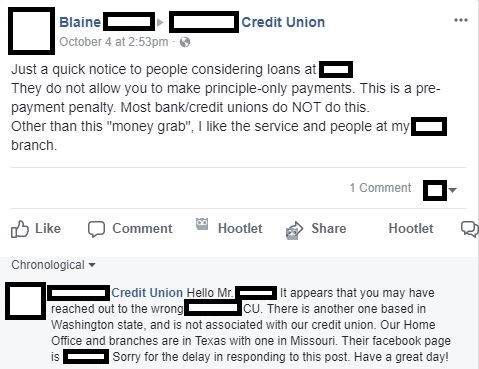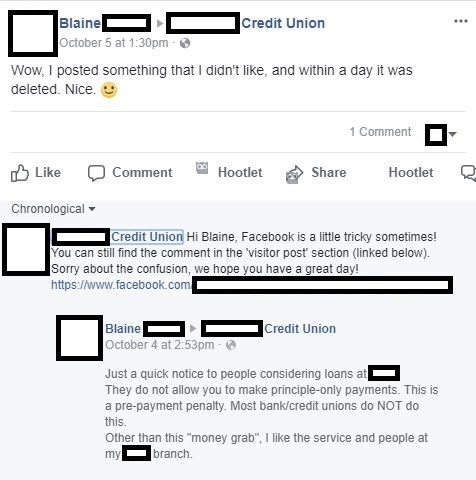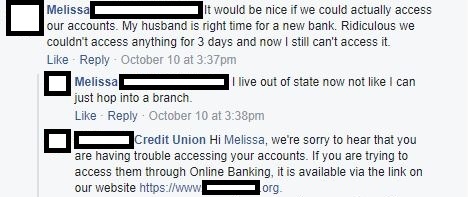Social Media Marketing: 4 Responses for Tough Comments 😱


Don't Miss An Episode, Subscribe Now
Negative reviews and comments are a common concern for business owners across all industries, including credit unions and banks. It's crucial for your social media marketing strategy to outline how to effectively address these negative comments online.
Whenever we start working with a new client, we have a checklist of items we review and update on the institution's Facebook page. Frequently, we come across instances where visitor posts and reviews are disabled, often due to the understandable apprehension of receiving negative comments or reviews. Best practices for social media marketing for Financial Institutions would tell us this is the exact reason every credit union SHOULD allow people to post and share, and here's why!
Credit Unions and Community Banks are known for their excellent customer service and flexibility to fit specific members' needs, so shouldn't you want to know if there is an issue? Think of it as an opportunity to improve! Here are some great examples to help you respond to a negative comment...
1) Mistaken Identity
Every once in a while, you may have a complaint that just doesn't make sense. In this example, the CU client realized he was NOT a member and lived in another state with a CU with a similar name. In this case, you should always publicly reply to the person and try to be as helpful as possible, as shown below:

2) Wrongfully Accused
In this example, the member thought that the CU deleted their previous comment on Facebook. It is important not to use negative language that may offend the user. Instead, we empathized with the member that Facebook does move things around quite often, and showed him where he could find his original comment, which was NOT deleted.

[DOWNLOAD NOW: Our Definitive Guide to Social Media Marketing for Financial Institutions]
3) A Complaint That is Not Descriptive
Sometimes the hardest complaints are the shortest ones. Many of our clients will see a comment like the one below and ask, 'Should we respond? What should we say?'
Our recommendation is to always respond, express gratitude for reaching out with feedback, and offer to discuss further offline to gain more insights and use the experience as a learning opportunity for your staff.

4) Find a Timely Solution
During a recent core conversion process, the Credit Union experienced challenges updating the URL to online banking on the homepage, causing delays in online banking availability for the first three hours.
This problem caused a lot of confusion and some frustration because members were told it would be available at 8 am, but it appeared not to be even after that time. In this case, we apologized for the inconvenience and shared a working link to the new online banking, while the homepage link was being fixed.

Here are some other more general tips for handling negative comments online:
- Acknowledge the user's frustration or complaint. No matter what their problem is, try to start your response off with an apology. 'We're sorry you're having trouble with...." or "We're sorry you had a bad experience with..." That way you own up to the problem and show your member you want to help. Even though most of the time the member may be part of the problem, NEVER focus on this in your response.
- Give an answer as fast as possible. Even if you do not immediately know the full answer, acknowledge the question and let them know you are working on finding a solution and will be back in touch asap. "Thank you for bringing this to our attention, I am going to reach out to my team member and get an answer back to you by the end of the day."
- Personalize your replies. You may not have all the answers but don't use the same response to everyone. It's okay to say something similar if it applies, but avoid copying the exact same reply to more than one person. Remember that these are all public and you will look less sincere if complaints are all handled with a canned response.
- Try to take the problem offline if it persists. If there is too much back and forth online ask the member if there is another way to communicate with them to discuss the specific details of the issue. "We would like to get to the bottom of this ASAP, is there a phone number we can reach you at? If so please send it to us in a private message."
- If a mistake was made, own it. Make sure to include language that acknowledges the CU may have made a mistake and will use it as a learning experience. "We will use this as a learning experience and do our very best to make sure it never happens again, thank you for giving us the opportunity to correct this problem."





Blog comments